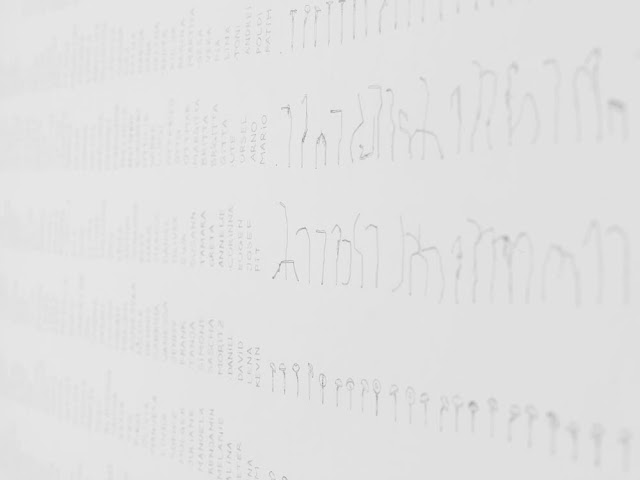Oben und Unten: Details und Installationsansicht Stapelholmer Barke,
Above and below: Details and installation view, Temporäre Galerie, Fotos: Jens Ziehe, 2014

Oben und unten: Detail gezeichnete Nägel der Stapelholmer Barke, Fotos: Jens Ziehe, 2014, Installationsansicht Nägel der Stapelholmer Barke, Foto: Chup Friemert, 2013
Above and below: Details of the drawn nails of the Stapelholm Skiff, fotos: Jens Ziehe, 2014, installation view of the nails of Stapelholm Skiff,
foto: Chup Friemaert, 2013
Above and below: Details of the drawn nails of the Stapelholm Skiff, fotos: Jens Ziehe, 2014, installation view of the nails of Stapelholm Skiff,
foto: Chup Friemaert, 2013
In dem 1000 Seelen Dorf Süderstapel entstandt die Stapelholmer Barke. Das Dorf liegt in der Region Stapelholm,
unweit des Nord-Ostsee-Kanals. Die Dörfer der Region sind
auf einem Geestrücken angesiedelt. Schwere Sturmfluten in den
Flussniederungen drängten Menschen im Mittelalter in sicherere Höhenlagen. Die damalige Klimaflucht ist die heutige Migration
junger Menschen in die Städte. Die fehlenden jungen Bewohner lassen leere Häuser zurück – für neue Bewohner aus Krisengebieten und Ländern außerhalb Europas.
The installation was created during an artist residency in the village of Süderstapel. It has a population of around 1000 inhabitants. The village lies in the North West of Germany not far from the Baltic sea on one side and the North sea on the other side. In medieval ages people were regularly threatened by storm floods entering the rivers from the seas. Many fled to hightened locations and founded villages there. These days the floods are controlled through a giant steel barrage placed at the mouth of the river Eider. Yet this steel barrage cannot control the movement of young people migrating to big cities. The missing young inhabitants are leaving empty houses behind – for people from regions struck by crisis or countries outside of Europe.
The installation was created during an artist residency in the village of Süderstapel. It has a population of around 1000 inhabitants. The village lies in the North West of Germany not far from the Baltic sea on one side and the North sea on the other side. In medieval ages people were regularly threatened by storm floods entering the rivers from the seas. Many fled to hightened locations and founded villages there. These days the floods are controlled through a giant steel barrage placed at the mouth of the river Eider. Yet this steel barrage cannot control the movement of young people migrating to big cities. The missing young inhabitants are leaving empty houses behind – for people from regions struck by crisis or countries outside of Europe.
Oben: Auseinandergenommene Möbel im "Ohlsenhaus", Süderstapel 2013
Above: Furniture taken apart in the the "Ohlsenhaus", Süderstapel 2013


